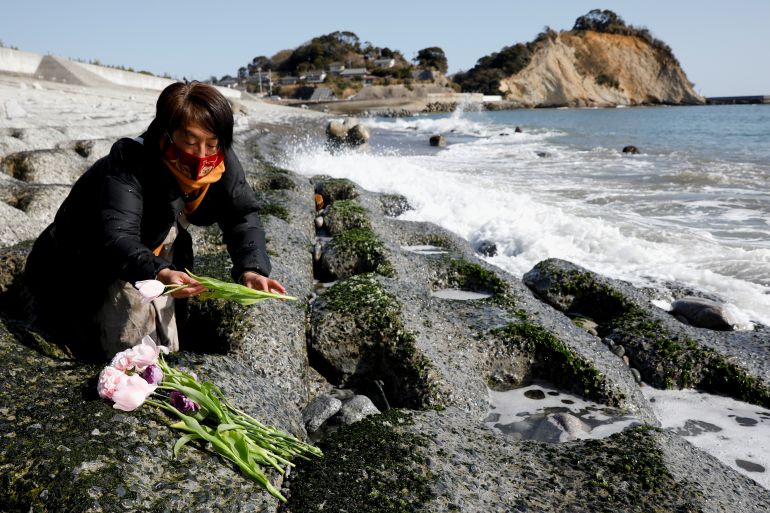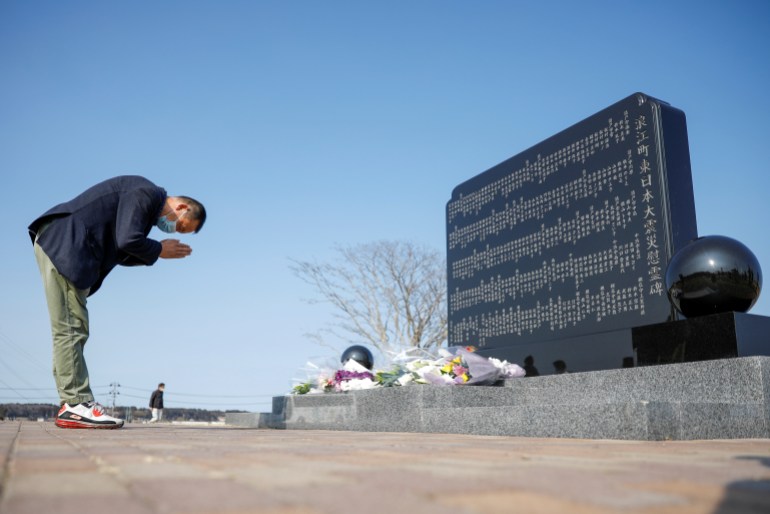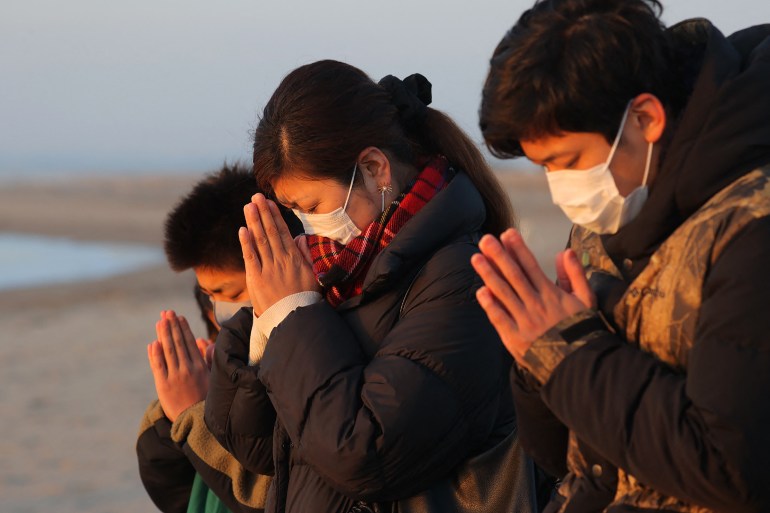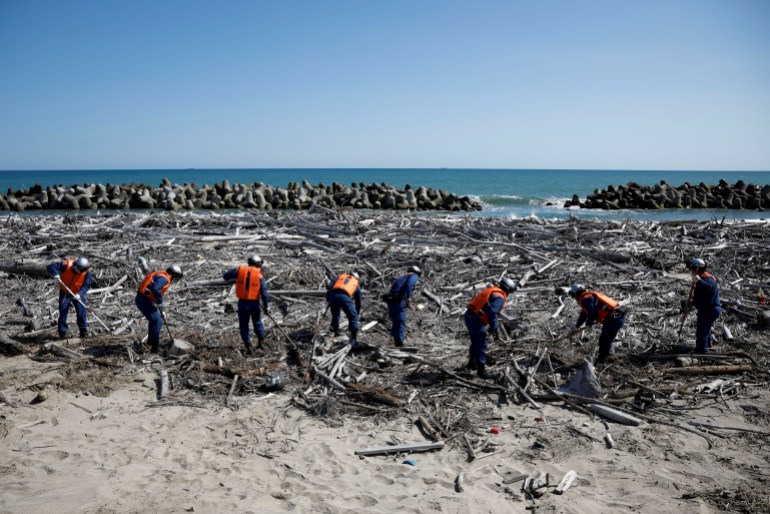Japan honours victims of 2011 earthquake, tsunami and nuclear disaster
Japan observes a minute of silence to commemorate the lives lost in the triple disaster of March 11, 2011.

Japan has paid tribute to the nearly 20,000 victims of a powerful earthquake and tsunami that struck the country 10 years ago, destroying entire towns and triggering the world’s worst nuclear disaster since Chernobyl.
Carrying bouquets, many people walked on Thursday to the coast or graves to pray for relatives and friends who died in the triple disaster, while a minute’s silence was held nationwide at 2:46 pm local time (05:46 GMT) – the precise moment the 9.0 magnitude quake hit off Japan’s northeast coast on March 11, 2011.
Keep reading
list of 4 itemsIn Pictures: Tsunami scars linger a decade later in Japan
The Fukushima disaster in maps and charts
How the 2011 tsunami destroyed Japan’s trust in nuclear power
The tremor triggered a huge tsunami that swept far inland, causing meltdowns at the Fukushima Daiichi nuclear power plant and forcing more than 160,000 residents to flee as radiation spewed into the air.
Emperor Naruhito and Prime Minister Yoshihide Suga joined a memorial for the dead at a ceremony in the Japanese capital, Tokyo, where the monarch said the “unforgettable memory of the tragedy” persisted a decade on.
“Many of those afflicted, in spite of their having suffered from unimaginably enormous damage, have overcome numerous hardships by helping one another,” he added.


The annual memorial event was held before a smaller audience than usual, with the capital and nearby areas currently under a state of emergency due to the COVID-19 pandemic.
Suga, the prime minister, said the challenges faced by survivors had been compounded by the pandemic and natural disasters, including a recent strong quake in the region, classified as an aftershock of the 2011 tremor.
But he said Japan had always “overcome every crisis with courage and hope”.
‘I came here to thank her’
In the hard-hit Tohoku region, the disaster has left survivors struggling to overcome the grief of losing families and whole communities to the 15-metre (49-foot) high wave.
In the town of Hisanohama, 78-year-old Toshio Kumaki walked to the giant sea wall built after the tsunami and offered a prayer to those who died. About 60 people were killed in one of the districts next to the beach, when the tsunami washed ashore, wiping away everything but a tiny shrine.
Kumaki’s eyes filled with tears as he remembered the disaster. “It was really scary,” he told the AFP news agency.
In the town of Ishinomaki, dozens of residents prayed at a cenotaph that carried the names of more than 3,000 victims, while in nearby Otsuchi, families in dark suits gathered on a piece of empty land where the town hall used to stand. The tsunami had destroyed the building, killing about 40 employees.
The government has spent about $300bn to rebuild the tsunami-devastated region, but areas around the Fukushima plant remain off-limits, worries about radiation levels linger and many who left have settled elsewhere. Decommissioning of the crippled plant will take decades and billions of dollars.
About 50 kilometres (31 miles) south of the Fukushima plant, in the gritty coastal city of Iwaki which has since become a hub for nuclear decommissioning workers, restaurant owner Atsushi Niizuma prayed to his mother killed in the tsunami.
“I want to tell my mother that my children, who were all close to her, are doing well. I came here to thank her that our family is living safely,” the 47-year-old told the Reuters news agency.
On the day of the disaster, Niizuma’s mother, Mitsuko, was looking after his children. The children rushed into a car. Mitsuko, 65, was swept away by the waves as she returned to the house to grab her belongings. It took a month to recover her body.
Searches for those still missing are taking place this week, as loved ones refuse to relinquish hope of finding them even a decade on.
The chances of success may appear slim, but just last week the remains of a woman missing since the tsunami were identified, in what her surviving son described as a chance to process his emotions and move forward.
‘Hope to people fighting COVID’
Thursday’s ceremony in Tokyo will be the last national commemoration for the 2011 disaster organised by the government. It comes just two weeks before the Olympic torch run begins from Fukushima ahead of the delayed Tokyo Summer Games in July.
Suga has said the Olympics will showcase Japan’s recovery from the disaster and will be proof of human victory against the coronavirus pandemic.
In her message of condolences, Tokyo 2020 President Seiko Hashimoto said the power of sport had become a focus of Tokyo’s bid for the Games after the 2011 disaster and that the concept could be extended to facing the coronavirus pandemic.
“While COVID-19 has led to the first-ever and unprecedented postponement of the Games, the role of sports within society has become ever more relevant,” Hashimoto said. “Even stronger determination” was needed to help boost the recovery of the areas hit by the earthquake and tsunami, she said.
“While doing so, we would like to do our best to bring together those whose lives have been affected by the global crisis through hosting a safe and secure Tokyo 2020 Games,” she said, referring to the coronavirus.


Tributes and condolences also poured in from around the world, including from United Nations Secretary Antonio Guterres and American singer Lady Gaga.
Guterres said he was thinking of those who continue to grieve the loss of loved ones, as well as those “who remain displaced, unable to return to their homes because of safety concerns”.
He said he also welcomed the findings of a UN report published on Tuesday, from the UN Scientific Committee on the Effects of Atomic Radiation, which concluded that no adverse health effects among residents of Fukushima had been found that could be directly attributed to radiation exposure.
Lady Gaga said the resilience of the Japanese people offered hope in the global fight against the coronavirus pandemic.
“Through the years, seeing and hearing about the vast recovery of your beautiful cities, I have so much respect to the people of Japan for your strength, kindness and love for each other,” the American singer and actress said in a video posted on her Twitter account.
“It gives hope to the people now that are fighting through the COVID pandemic all around the world.”
Antony Blinken, the US Secretary of State, also offered a message of support.
“The United States stands in solidarity with Japan to remember those lost and still missing, and to honor the resilience of the Japanese people who rebuilt their homes, their livelihoods, and their communities,” he said.